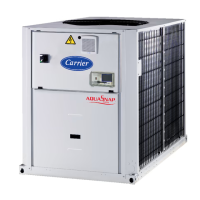5
Do not remove the skid or the packaging until the unit is
in its nal position. These units can be moved with a fork
lift truck, as long as the forks are positioned in the right
place and direction on the unit.
More particularly, units equipped with the optional buffer
tank module can be handled by forklift in compliance with
the instructions below:
- Pick up the load as close as possible to the mast (at
the heel of the fork)
- The forks of the forklift must pass all the way under
the load
- The load must be lowered down a slope in reverse,
with the mast tilted backwards
- The load must be raised up a slope in forwar gear,
with the mast tilted backwards
In both cases, drive at low speed, applying the brakes
gradually.
The units can also be lifted with slings, using only the
designated lifting points marked on the unit (labels on the
chassis and a label with all unit handling instructions are
attached to the unit).
Use slings with the correct capacity, and always follow the
lifting instructions on the certied drawings supplied for
the unit.
Safety is only guaranteed, if these instructions are carefully
followed. If this is not the case, there is a risk of material
deterioration and injuries to personnel.
DO NOT COVER ANY PROTECTION DEVICES.
This applies to fuse plugs and relief valves (if used) in the
refrigerant or heat transfer medium circuits. Check if the
original protection plugs are still present at the valve outlets.
These plugs are generally made of plastic and should not be
used. If they are still present, please remove them. Install
devices at the valve outlets or drain piping that prevent the
penetration of foreign bodies (dust, building debris, etc.) and
atmospheric agents (water can form rust or ice). These
devices, as well as the drain piping, must not impair operation
and not lead to a pressure drop that is higher than 10% of
the control pressure.
Classication and control
In accordance with the Pressure Equipment Directive and
national usage monitoring regulations in the European
Union the protection devices for these machines are classied
as follows:
High-pressure switch x
External relief valve*** x
Rupture disk x
Fuse plug x
External relief valve **** ****
*** The instantaneous over-pressure limited to 10% of the operating pressure
the high-pressure switch ensures that the service pressure is not exceeded in
Do not remove these valves and fuses, even if the re risk is
under control for a particular installation. There is no
guarantee that the accessories are re-installed if the installation
is changed or for transport with a gas charge.
When the unit is subjected to re, safety devices prevent
rupture due to over-pressure by releasing the refrigerant.
The uid may then be decomposed into toxic residues when
subjected to the ame:
- Stay away from the unit.
- Set up warnings and recommendations for personnel in
charge to stop the re.
- Fire extinguishers appropriate to the system and the
refrigerant type must be easily accessible.
All factory-installed relief valves are lead-sealed to prevent
any calibration change.
The external relief valves must always be connected to drain
pipes for units installed in a closed room (30RQSY). Refer
to the installation regulations, for example those of European
standard EN 378 and EN 13136.
These pipes must be installed in a way that ensures that
people and property are not exposed to refrigerant leaks.
As the uids can be diffused in the air, ensure that the outlet
is far away from any building air intake, or that they are
discharged in a quantity that is appropriate for a suitably
absorbing environment.

